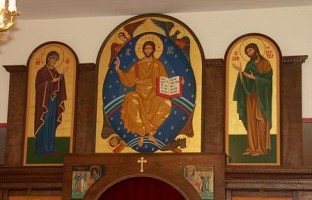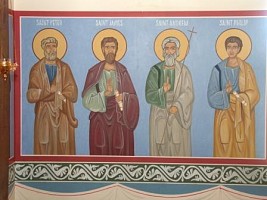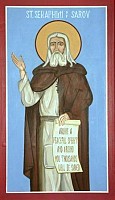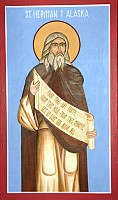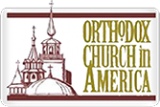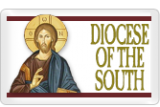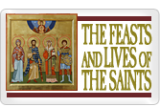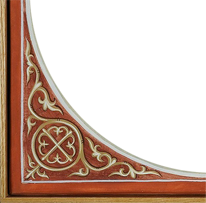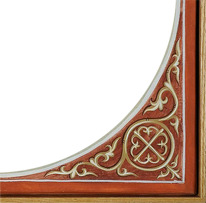Icons are not works of fine art but are the theology of Christianity put forth in images and colors. They are created to reveal God. St.Theodore the Studite tells us that "in the Sacred Scriptures we have the written word of God, in the Icons we have his word in images."
Icons are said to be "windows into heaven." This is so because it is a two way communication between the one praying and the one depicted in the icon. A communication sometimes without words, but a communication of presence for through the icon, one is made present to the one depicted and vice versa. It is through this link that we ask the one in the icon to intercede for us with our Savior.
In our veneration of the saints we see that they have lived their lives in accord with God's will and so Christ dwells in them. It is in this very indwelling that through the saint we worship Christ himself.
Our society and culture dictate that one must always be doing something. Even in prayer we seem to have the need for words or actions. In the stillness of silent prayer, icons help us to put aside the noise, the business, the pressures and the problems of everyday life and in the quiet listen to God.
For those new to icons the temptation to verbalize prayer whether vocal or interior must be resisted. We must give up our control and experience the silence. Those experienced in prayer with icons testify that God speaks to us through the icon. There are many moments when nothing seems to happen but one must be faithful, spending time each day with the icon, watchful, silent, receptive, open.
Because icons are theological in nature. there is no effort made to be physically accurate in their presentation as you would have in a photograph. Rather the opposite is true, naturalism is absent, perspective is inverse with the vanishing point not in the distant background but focusing in the foreground at the ones looking at the icon, drawing them into it. Icons contain and speak the Gospel truths with images in the light of the Sacred Tradition of the church. They must be distinct from other types of images just as the Gospel is different from all other literary works. No matter how simple and crude or elaborate and grand, icons are mystical works of worship.
An icon may depict the Savior, the Mother of God, angels, saints or a scriptural scene. The Orthodox Church celebrates the great feasts with festal icons such as the birth of the Mother of God, the Baptism of our Lord, the Transfiguration, and the like. The icon is venerated in church from the forefeast to the leavetaking of the feast.
Everything in the icon has meaning beginning with the colors. Blue is the color of divinity, red humanity, gold and white the glory and the light of God. The white areas or lines on the flesh and clothing represent the transfigured light of Christ. Prophets always have a scroll in their hand, rolled or open with a text visible, martyrs are clothed in red and bishops are shown in their liturgical vestments. Based on the Old Testament importance given to a person's name, all icons have the name of the person depicted inscribed on them. It is traditional to put the name of Jesus and the Mother of God in Greek while using the vernacular for the others. The border separates the icon from the everyday world. Icons are never put in frames, rather the wooden panels are hung directly on the wall. The icon is considered complete when the name of the person depicted is inscribed and it is blessed on the altar.
Traditional iconography belongs to the One, Holy, Catholic and Apostolic Church. It has been part of her tradition since the very beginning of Christianity. Throughout the centuries she has developed and maintained iconographic canons, customs and traditions to ensure the accuracy of the images in content, colors, perspectives and even materials. The Orthodox Church has strictly protected the iconographic tradition, first from iconoclasm, then from other distortions, such as artistic idiosyncrasies and private opinions.
Icon painting demands an artistic talent plus the daily living of an intense spiritual life in The Church. An authentic icon painter must be a theologian of the image because iconography is a language, which implies a living faith. Icons are not meant to express an iconographer's originality or self-expression rather they take great care to be faithful to the iconographic canons. Just as written translations of the Gospel must remain true to the original texts, so too must the iconographer remain faithful to the iconographic canons. They use the same methods and depict the same subjects as their predecessors and they do not sign their work. Iconographers are expected to fast and pray from beginning an icon to its completion. They pray for divine guidance and assistance in their work and they pray for those that will kneel before and venerate the icon. They fast for purification mind and heart.
Icons play an important part in the prayer of the Church, public and private. Publicly they bring the divine presence into the sacred place used by the community for Liturgy. During liturgy they are venerated and give a visual, real dimension to the actual presence of Christ, the Mother of God and the saints. They are also carried in processions.
In the homes of the faithful they bring that same divine presence to the private prayer of the individual. In each home there should be a Prayer Comer with Sacred Scriptures and icons, in order to be there, "in secret before our Father." In addition to Sacred Scripture and icons, candles, incense and sometimes sacred music help to provide an environment conducive to prayer. This home chapel or room, or any other special place should enable silence and be distraction free.
It is also customary for people to carry their icons with them when they travel to provide the opportunity for prayer while they are away from the chapel in their home. Many other customs involving icons developed over the centuries, one being the custom of giving an icon to the newly married couple as they establish their home together.
As we contemplate the icon we cannot help but be drawn into it and the image looks back at us. All of the light in the icon comes from within the person in the image. There are no exterior light sources, no shadows. Only the transfigured light of Christ. The common features of the secular world are absent in the icon because it is our glimpse, our look through the window into heaven.
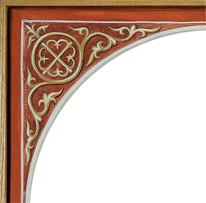
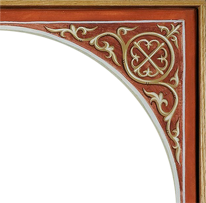

 Orthodoxy in America
Orthodoxy in America